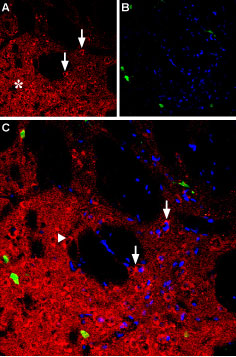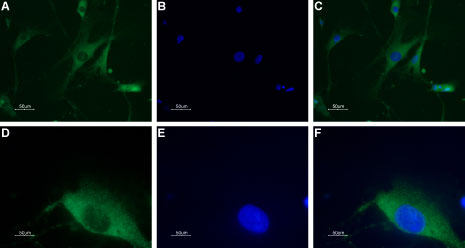Overview
- Peptide (C)RLKRRNNMMDKMRDNK, corresponding to amino acid residues 237-252 of human NPY1R (Accession P25929). 3rd intracellular loop.

 Western blot analysis of human Jurkat acute T cell leukemia (lanes 1 and 4), human K562 chronic myelogeneous leukemia (lanes 2 and 5), and rat RBL basophilic leukemia (lanes 3 and 6) cell lysates and rat brain lysates (lanes 7 and 8):1,2,3,7. Anti-NPY1R Antibody (#ANR-021), (1:200).
Western blot analysis of human Jurkat acute T cell leukemia (lanes 1 and 4), human K562 chronic myelogeneous leukemia (lanes 2 and 5), and rat RBL basophilic leukemia (lanes 3 and 6) cell lysates and rat brain lysates (lanes 7 and 8):1,2,3,7. Anti-NPY1R Antibody (#ANR-021), (1:200).
4,5,6,8. Anti-NPY1R Antibody, preincubated with NPY1R Blocking Peptide (#BLP-NR021).
 Expression of neuropeptide Y1 receptor in rat striatumImmunohistochemical staining of rat striatum using Anti-NPY1R Antibody (#ANR-021). A. NPY1R (red) appears in the striatal matrix (white asterisk) and in medium-size cells in the matrix (arrows). B. Parvalbumin (green) appears in the striatal matrix. C. Confocal merge of NPY1R and parvalbumin indicates that NPY1R is restricted to granule cells. DAPI is used as the counterstain (blue).
Expression of neuropeptide Y1 receptor in rat striatumImmunohistochemical staining of rat striatum using Anti-NPY1R Antibody (#ANR-021). A. NPY1R (red) appears in the striatal matrix (white asterisk) and in medium-size cells in the matrix (arrows). B. Parvalbumin (green) appears in the striatal matrix. C. Confocal merge of NPY1R and parvalbumin indicates that NPY1R is restricted to granule cells. DAPI is used as the counterstain (blue).
 Expression of neuropeptide Y1 receptor in DRG neuronsImmunocytochemical staining of a primary culture of rat dorsal root ganglion (DRG) neurons. A, D. A paraformaldehyde-fixed and permeabilized DRG primary culture was stained with Anti-NPY1R Antibody (#ANR-021), (1:100), followed by Alexa-555-conjugated goat-anti-rabbit secondary antibody. B, E. Nuclear fluorescence staining of cells using the membrane-permeable DNA dye Hoechst 33342. C. Merged images of A and B. F. Merged images of D and E.
Expression of neuropeptide Y1 receptor in DRG neuronsImmunocytochemical staining of a primary culture of rat dorsal root ganglion (DRG) neurons. A, D. A paraformaldehyde-fixed and permeabilized DRG primary culture was stained with Anti-NPY1R Antibody (#ANR-021), (1:100), followed by Alexa-555-conjugated goat-anti-rabbit secondary antibody. B, E. Nuclear fluorescence staining of cells using the membrane-permeable DNA dye Hoechst 33342. C. Merged images of A and B. F. Merged images of D and E.
Magnification:
A-C: x20
E-F: x100
- Stanic, D. et al. (2006) J. Comp. Neurol. 499, 357.
- Körner, M. et al. (2004) Clin. Cancer Res. 10, 8426.
- Sun, L. and Miller, R.J. (1999) J. Neurophysiol. 81, 1391.
- Bournat, J.C. and Allen, J.M. (2001) Brain Res. Mol. Brain Res. 90, 149.
- Wheway, J. et al. (2005) J. Exp. Med. 202, 1527.
Neuropeptide Y (NPY) is a 36-amino acid peptide neurotransmitter in the central (CNS) and peripheral nervous systems.1 It belongs to the NPY family, together with the peptide YY (PYY) and the pancreatic polypeptide (PP). NPY is involved in regulation of a broad range of homeostatic functions such as eating behavior, hypertension, and reproduction.2
NPY exerts its effects via five receptor subtypes known as the neuropeptide Y receptors (NPYR): Y1 (NPY1R), Y2 (NPY2R), Y4 (NPY4R), Y5 (NPY5R) and Y6 (NPY6R).2 Four of these, Y1, Y2, Y4, and Y5, are expressed in humans.2
The NPY receptors belong to the G protein-coupled receptor superfamily whose members share a common structure of seven putative transmembrane domains, an extracellular amino terminus, and a cytoplasmic carboxyl terminus.
Activation of these receptors by NPY produces effects on [Ca2+]i, adenylate cyclase, and a number of ion channels.3 Based on the high frequency and density of NPY receptors in steroid hormone-producing tumors, the NPY receptors might be of potential use in tumor management.2
NPY1R is considered to be a postsynaptic receptor. In the CNS, NPY1Rs are concentrated in the cortical areas of the brain, cerebral cortex, olfactory nucleus, hippocampus, hypothalamic nuclei, and thalamic nuclei.4 In addition, this receptor has a bimodal role in the immune system, serving as a strong negative regulator on T cells as well as a key activator of antigen-presenting cell function.5
Application key:
Species reactivity key:
Alomone Labs is pleased to offer a highly specific antibody directed against an intracellular epitope of the human neuopeptide Y1 receptor (NPY1R). Anti-NPY1R Antibody (#ANR-021) can be used in western blot analysis, immunohistochemistry, and immunocytochemical applications. It has been designed to recognize NPY1R from human, rat, and mouse samples.
